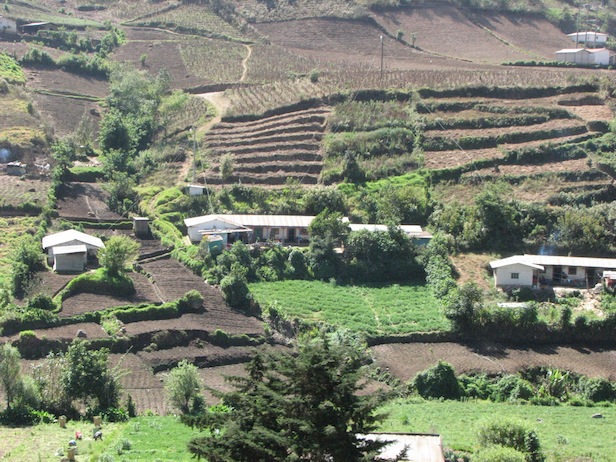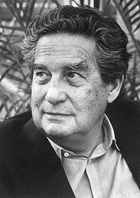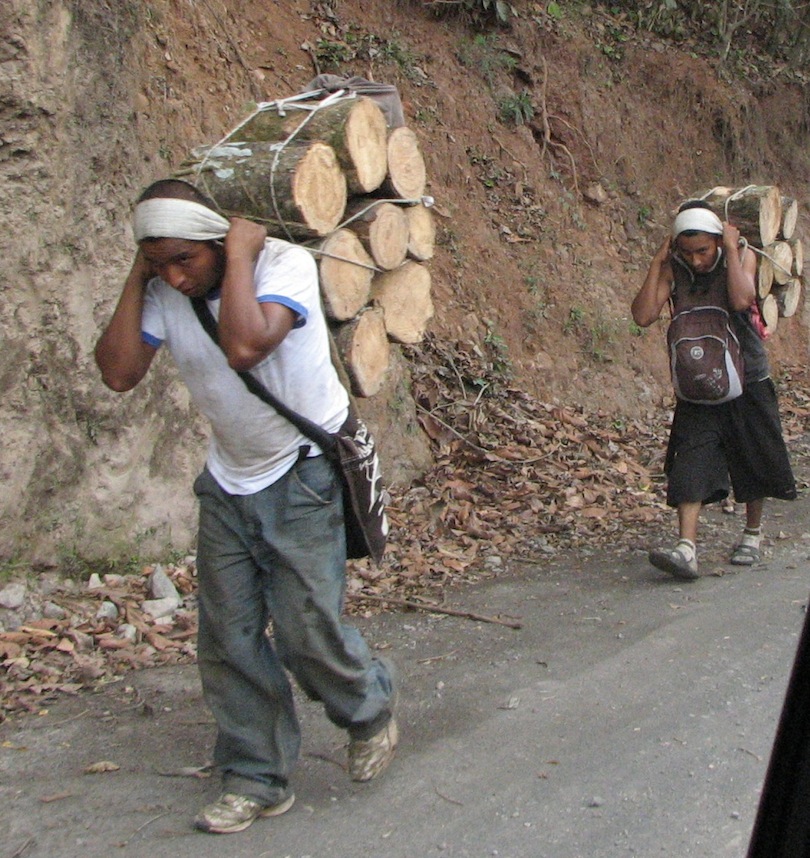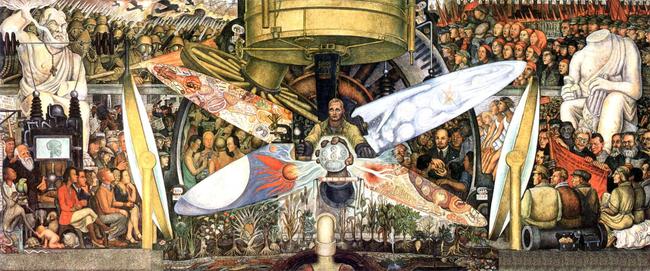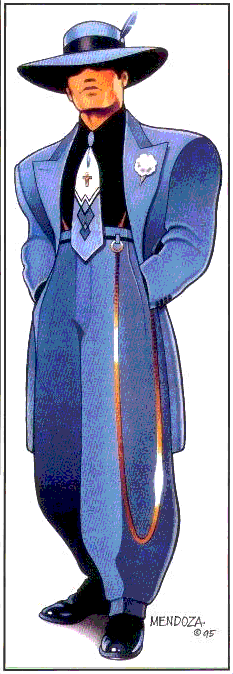The Mayan fields shape the countryside due to ancient, inherited agricultural practices.
Clarify to Organize and Reflect in order to Evaluate
Octavio Paz's interpretations of mestizo cultural identity
Diplomat and Nobel Prize winning author, Paz engages the reader in a journey that begins as a personal search only to end up uncovering a universal pattern of expression that reflects our human dignity.
Paz suggests that "But however influential the systems of production may be in shaping of a culture, I refuse to believe that as soon as we have heavy industry and are free of all economic imperialism, the differences will vanish."
1. Growing up
2. Reflection
3. Analogy
5. Universality
7. Hope
"What is the origin of such contradictory attitudes? It seems to me that North Americans consider the world as something that can be perfected, and that we consider it something that can be redeemed."
(p. 24)
A narrative as a way to arrange & order concepts, arguments, and evidence.
Authors | Introduction | Argument | Question | Evidence | Source | Summary
What to know:
Like Crosby, Paz argues that identity is molded by a relation to the 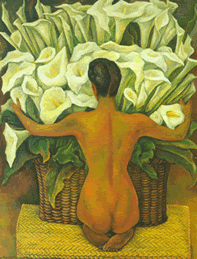 past but not merely the agricultural traditions of a people. Paz like Mintz he understands the essential role of fashion to cover over the tensions that challenge people to overcome their isolation because it is this process of transcendence that drives social behavior. And he argues that Mexicans like all people have to transcend their confinement in the myths and rituals they have inherited to make real meaning out of the tragedy of their historically mixed condition.
past but not merely the agricultural traditions of a people. Paz like Mintz he understands the essential role of fashion to cover over the tensions that challenge people to overcome their isolation because it is this process of transcendence that drives social behavior. And he argues that Mexicans like all people have to transcend their confinement in the myths and rituals they have inherited to make real meaning out of the tragedy of their historically mixed condition.
![]()
Paz instead argues that social transformation and not simply a demographic or ecological change in conditions starts as a personal experience. That personal experience must confront the horror of the collective past if people, an entire culture, a nation, and all the world's people are able to confront the dire circumstances faced in the present.
He uses the example of the Mexican-American male, the Chicano as a symbol of misplaced people everywhere who are detached from the cultural heritage
As such he insists that you recognize that the Pachuco is a "sinister clown whose purpose is to cause terror instead of laughter."
p. 16.
The Pachuco is both a reality and a symbol as the main event in Paz's narrative. The story of the pachuco as an example of a displaced migrant is Paz's way to explain the contrasting personality differences between Mexican & North American or US cultures.
As Paz says, "I am only trying to clarify the meaning of certain experiences. . . ."
A narrative as a way to arrange & order concepts, arguments, and evidence.
Authors | Introduction | Argument | Question | Evidence | Source | Summary
Culture
For Paz, culture must be understood in "the sense of a complex of values created and shared in common – stems from the conviction . . . .”
Paz, p. 26.
A reflection exercise based on related steps.
 In a paragraph describe the opening five paragraphs in Paz with a space for noting the page references
In a paragraph describe the opening five paragraphs in Paz with a space for noting the page references
"work with the realities of our situation"
"He goes through a reflective stage"
pp. 10-11.
Argument
Now compare the paragraph you have made in steps to Paz's description of the human place in history:
1) "Man is alone everywhere." For example, "The Spanish dream was broken."
pp. 19, 27.
2) "The history of Mexico is the history of man seeking his parentage, his origins. He has been influenced at one time or another by France, Spain, the United States and the militant indiginists of his own country, and he crosses history like a jade comet, now and then giving off flashes of lightning."
"He wants to go back beyond the catastrophe he suffered. . . . he wants to return to the center of life from which he was separated one day."p. 20.
A narrative as a way to arrange & order concepts, arguments, and evidence.
Authors | Introduction | Argument | Question | Evidence | Source | Summary
Contrast verbally and in writing.
contrast, to draw into opposition; to place in stark relief by contrasting–
Secondly, Then summarize the contrasts that Paz delineates between Mexican culture and the cultural attitudes of people in the North America:
"In the United States man does not feel that he has been torn from the center of creation and suspended between hostile forces."
p. 20.
Next.
Evidence
Geography and its related ecology is symbolically re-expressed as if it were filtered by cultural norms:
"He has built his own world and it is built in his own image; it is his mirror. But now he cannot recognize himself in his human objects, nor in his fellows. His creations like those of an inept sorcerer, no longer obey him. He is alone among his works, lost . . . in a wilderness of mirrors."
Human relations today are the product of those social habits dictated by culture, not just the transformed ecology, and they have isolated North Americans as our society "respects the existing systems and never touches the roots."
p. 21
| Terms | |||
|---|---|---|---|
| Ecological Factors | |||
| health | |||
| Cycle of relations | population |  |
surroundings |
| Cultural norms: | "inhabited by a number of races" | fashion | "places" |
| food | |||
| Paz's insight: | "man the intruder has broken or violated the order of the universe" | ||
| land pyramid | 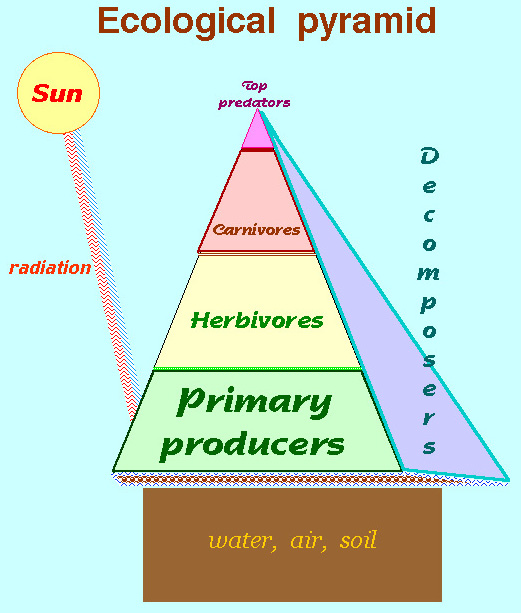 |
||
| ingredients | nutrients | land | water |
![]()
Retell his story verbally and in writing.
 with respect to your paragraph, now consider if Paz chapter fits the narrative form we have here.
with respect to your paragraph, now consider if Paz chapter fits the narrative form we have here.
Here are the apparent stages in every narrative:
stage the question it answers? phrase to use
- Preconditions –what we need to know "He goes through a reflective stage"
p. 11.
- The buildup – events leading up to "I am trying to explain to myself some of the traits of the . . .Mexican"
"This Mexicanism floats"
pp. 12-13.
- The main event –what this narrative is about Pachucos "but solitude is a hard fact"
pp. 14-17.
- The purpose –what is achieved; what it means – emerges in the contrasts
- "But the solitude of the Mexican, under the great stone night of the high plateau that is still inhabited by insatiable gods, is very different from the North American."
- "In the Valley of Mexico man feels himself suspended between heaven and hell, and he oscillates between contrary powers and forces, and petrified eyes and devouring mouths."
- The wind-down –events that end the process: The Spanish Civil War and his recognition of Hope within the hopelessness of struggle.
The result –the final context of the events (embedding), the meaning is that:pp. 27-28.
"In every person there is the possibility of us . . . becoming -once again- another person."
North America must also escape "aseptic moral purity."
p. 25.
"our mutual inability to reconcile ourselves to the flux of life."
p. 26.
A narrative as a way to arrange & order concepts, arguments, and evidence.
Authors | Introduction | Argument | Question | Evidence | Source | Summary
Summarize the dialectical analogies that Paz makes.
This thinking – analogical analysis – means breaking things down into comparable concepts that make up a bigger whole. This process of analysis is what serious thinking is all about. The outcome is the practice and improvement of a critical capacity to distinguish errors from verity.
Describe how many ways the observations about the narrative elements explained above are or are not part of Paz's argument.
"Contemporary history invalidates the belief" in human modification "Man, it seems to me, is not in history, he is history".
p. 24-25.
next
Fourthly, Now pull separate themes together by first drawing lines to connect between related items.
"man the intruder has broken or violated the order of the universe" (p. 26.) >-----------------------------> "habits inherited from the Indians & the Spanish . . . are now an inseparable part of our being."(p. 23.)
Describe the common elements in Paz where he uses examples of influences and factors that appear more than once in the chapter or so frequently that his argument is clarified.
"The mask that replaces the dramatic mobility of the human face is benevolent and courteous but empty of emotion, and its set smile is almost lugubrious: it shows the extent to which intimacy can be devastated by the arid victory of principles over instincts.
"The sadism underlying almost all types of relationships in contemporary North American life is perhaps nothing more than a way of escaping the petrification imposed by that doctrine of aseptic moral purity."
p. 25.
A narrative as a way to arrange & order concepts, arguments, and evidence.
Authors | Introduction | Argument | Question | Evidence | Source | Summary
![]()
Fashion & Style: The ambiguities of the "Pachuco."
The juxtaposition of extremes " an orphan lacking both protectors and positive values." thesis "His disguise is a protection." novelty imitation "It both hides him and points him out." antithesis
A narrative as a way to arrange & order concepts, arguments, and evidence.
Authors | Introduction | Argument | Question | Evidence | Source | Summary
 Question?
Question?
What is Paz's point here?
"In every person there is the possibility of his being, or to be more exact – of his becoming – once again – another person."
How is it critical:
"our mutual inability to reconcile ourselves to the flux of life."
p. 26.
![]()
Summary of the Columbian Exchange's importance.
The Columbian Exchange: Biological and Cultural Consequences of 1492, New York: Greenwood Press, 1972.
Mintz, Food, . . . pp. xv-18 European colonial rivalry and scars of imperialism,
Crosby's underlying assumptions from Germs Seeds and Animals.
Crosby's ultimate conclusions.
Caribbean Study Guide
Comparing authors
A narrative as a way to arrange & order concepts, arguments, and evidence.
Authors | Introduction | Argument | Question | Evidence | Source | Summary
How does this relate to CORE? In order to evaluate the Paz book by reflecting on his dialectical arguments we must initially clarify, organize into a narrative, reflect on the authors, and evaluate how to put a series of related arguments together based on evidence into a logical framework.
